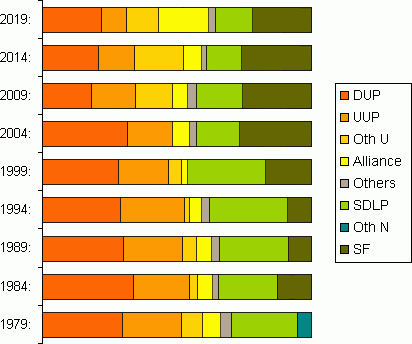

 |
 |
|
|
|
|
For more information about the European Parliament and European elections see the 2009 European elections page.
The first preference votes cast in the European election in Northern Ireland on 9 June 1994 (see spreadsheet):
The campaign took place at a very odd period of Northern Ireland politics. The Brooke-Mayhew talks had broken down in late 1992; the Downing Street Declaration of December 1993 appeared to have initiated official indirect dialogue between the British government and Sinn Fein (as opposed to the unofficial direct dialogue that had been made public shortly before); and we were moving towards the IRA and Loyalist ceasefires of the second half of the year.
This odd moment was reflected by the odd assortment of the record number of candidates, apart from the three incumbents who fought the standard campaigns - Paisley, as a referendum on the Downing Street Declaration, fulminating against the UUP for not cutting off relations with the British government; Hume, hoping not unrealistically to top the poll for the first time; Nicholson, fighting as the only full-time MEP. But Alliance chose a leading feminist who had never fought an election before, hoping (quite unrealistically) to echo the success of Mary Robinson in the Republic. I wrote her election manifesto, for what that is worth. Both Sinn Fein and the Natural Law Party chose to run three candidates for the three places; in the case of the latter, inexperience can excuse this bizarre choice, but SF were I think hoping to capitalise on the candidates' regional strengths to pull their vote up from 1989. Their overall vote did increase slightly, but they lost three deposits and I don't think it was a winning strategy. For the Conservatives this was an attempt to show that their support could last more than one electoral cycle, after the disappointing local election results the previous year; it was not a success for them. The three candidates backing an independent NI reflected the uncertainty in the air about the future. Only Ross had a real organisation of any sort (one of the leading paramilitary groups was supposedly helping with his campaign - well I'd prefer them to do that than shoot people). Mooney had fought a couple of local elections in North Down and has since stood in a couple more, with a total lack of success. Finally, Campion's candidacy was supported by Democratic Left, the Greens, and some of the Labour groups (who now seem to be working with Bob McCartney).
Paisley's surplus of 23,279 was then distributed to the next available preference as follows:
One other point about Paisley's vote that is worth considering is that in the cases of both Sinn Féin and the Natural Law Party, the one female candidate of the three received most transfers from him. Opinion polls occasionally show stronger support for the DUP among women than men. I do not particularly want to draw this point out any further...
Finally I was privately glad that the record for the lowest vote in an NI European electon, previously held by Jimmy Murray of the Ulster Liberal Party who got only 932 votes in 1979, was comprehensively shattered by four of the candidates in 1994. Jimmy (who died in 1998) was a good guy who deserved a better result.

This graph shows the performances of the main parties in the five direct elections to the European parliament held so far (NB that the 2004 result in yellow is that of independent candidate John Gilliland, not the Alliance Party). You can find a summary of the results of the five most recent NI elections at all levels on this site's home page and on a different page is a summary of NI election results since 1973.
See also:
Other sites based at ARK: ORB (Online Research Bank) | CAIN (Conflict Archive on the INternet) | Northern Ireland Life and Times Survey
Your comments, please! Send an email to me at nicholas.whyte@gmail.com.
Nicholas Whyte, 16 February 2002
|
Disclaimer:© Nicholas Whyte 1998-2004 Last
Updated on
Saturday, 30-May-2009
10:33
|